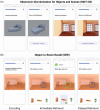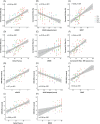Remote and unsupervised digital memory assessments can reliably detect cognitive impairment in Alzheimer's disease
- PMID: 38867417
- PMCID: PMC11247711
- DOI: 10.1002/alz.13919
Remote and unsupervised digital memory assessments can reliably detect cognitive impairment in Alzheimer's disease
Abstract
Introduction: Remote unsupervised cognitive assessments have the potential to complement and facilitate cognitive assessment in clinical and research settings.
Methods: Here, we evaluate the usability, validity, and reliability of unsupervised remote memory assessments via mobile devices in individuals without dementia from the Swedish BioFINDER-2 study and explore their prognostic utility regarding future cognitive decline.
Results: Usability was rated positively; remote memory assessments showed good construct validity with traditional neuropsychological assessments and were significantly associated with tau-positron emission tomography and downstream magnetic resonance imaging measures. Memory performance at baseline was associated with future cognitive decline and prediction of future cognitive decline was further improved by combining remote digital memory assessments with plasma p-tau217. Finally, retest reliability was moderate for a single assessment and good for an aggregate of two sessions.
Discussion: Our results demonstrate that unsupervised digital memory assessments might be used for diagnosis and prognosis in Alzheimer's disease, potentially in combination with plasma biomarkers.
Highlights: Remote and unsupervised digital memory assessments are feasible in older adults and individuals in early stages of Alzheimer's disease. Digital memory assessments are associated with neuropsychological in-clinic assessments, tau-positron emission tomography and magnetic resonance imaging measures. Combination of digital memory assessments with plasma p-tau217 holds promise for prognosis of future cognitive decline. Future validation in further independent, larger, and more diverse cohorts is needed to inform clinical implementation.
Keywords: Alzheimer's disease; ambulatory assessments; blood‐based biomarkers; digital cognitive markers; ecological momentary assessments; mHealth; memory; plasma marker; smartphone‐based unsupervised assessments.
© 2024 The Author(s). Alzheimer's & Dementia published by Wiley Periodicals LLC on behalf of Alzheimer's Association.
Conflict of interest statement
O.H. has acquired research support (for the institution) from ADx, AVID Radiopharmaceuticals, Biogen, Eli Lilly, Eisai, Fujirebio, GE Healthcare, Pfizer, and Roche. In the past 2 years, he has received consultancy/speaker fees from AC Immune, Amylyx, Alzpath, BioArctic, Biogen, Cerveau, Eisai, Eli Lilly, Fujirebio, Merck, Novartis, Novo Nordisk, Roche, Sanofi and Siemens. S.P. has acquired research support (for the institution) from ki elements/ADDF and Avid. In the past 2 years, he has received consultancy/speaker fees from Bioarctic, Biogen, Eisai, Lilly, and Roche. E.D. reports personal fees from Biogen, Roche, Lilly, Eisai and UCL Consultancy as well as non‐financial support from Rox Health. D.B. and E.D. are scientific co‐founders of neotiv GmbH and own company shares. The other authors report no competing interests. Author disclosures are available in the supporting information.
Figures





Similar articles
-
Integrating plasma p-tau217 and digital cognitive assessments for early detection in Alzheimer's disease.Alzheimers Dement. 2025 Jun;21(6):e70355. doi: 10.1002/alz.70355. Alzheimers Dement. 2025. PMID: 40491259 Free PMC article.
-
Unsupervised high-frequency smartphone-based cognitive assessments are reliable, valid, and feasible in older adults at risk for Alzheimer's disease.J Int Neuropsychol Soc. 2023 Jun;29(5):459-471. doi: 10.1017/S135561772200042X. Epub 2022 Sep 5. J Int Neuropsychol Soc. 2023. PMID: 36062528 Free PMC article.
-
Digital cognitive assessments as low-burden markers for predicting future cognitive decline and tau accumulation across the Alzheimer's spectrum.Alzheimers Dement. 2024 Oct;20(10):6881-6895. doi: 10.1002/alz.14154. Epub 2024 Sep 6. Alzheimers Dement. 2024. PMID: 39239892 Free PMC article.
-
Current advances in digital cognitive assessment for preclinical Alzheimer's disease.Alzheimers Dement (Amst). 2021 Jul 20;13(1):e12217. doi: 10.1002/dad2.12217. eCollection 2021. Alzheimers Dement (Amst). 2021. PMID: 34295959 Free PMC article. Review.
-
A review of novel Cognitive Challenge Tests for the assessment of preclinical Alzheimer's disease.Neuropsychology. 2023 Sep;37(6):661-672. doi: 10.1037/neu0000883. Epub 2022 Dec 8. Neuropsychology. 2023. PMID: 36480378 Free PMC article. Review.
Cited by
-
Tau, atrophy, and domain-specific cognitive impairment in typical Alzheimer's disease.Alzheimers Dement. 2025 Jul;21(7):e70511. doi: 10.1002/alz.70511. Alzheimers Dement. 2025. PMID: 40709494 Free PMC article.
-
Amyloid-Beta Deposition in Basal Frontotemporal Cortex Is Associated with Selective Disruption of Temporal Mnemonic Discrimination.J Neurosci. 2025 Mar 5;45(10):e1605242025. doi: 10.1523/JNEUROSCI.1605-24.2025. J Neurosci. 2025. PMID: 39843236
-
A scoping review of remote and unsupervised digital cognitive assessments in preclinical Alzheimer's disease.medRxiv [Preprint]. 2025 Mar 25:2024.09.25.24314349. doi: 10.1101/2024.09.25.24314349. medRxiv. 2025. Update in: NPJ Digit Med. 2025 May 10;8(1):266. doi: 10.1038/s41746-025-01583-5. PMID: 39399008 Free PMC article. Updated. Preprint.
-
Moving toward the digitalization of neuropsychological tests: An exploratory study on usability and operator perception.Digit Health. 2025 May 5;11:20552076251334449. doi: 10.1177/20552076251334449. eCollection 2025 Jan-Dec. Digit Health. 2025. PMID: 40343060 Free PMC article.
-
A scoping review of remote and unsupervised digital cognitive assessments in preclinical Alzheimer's disease.NPJ Digit Med. 2025 May 10;8(1):266. doi: 10.1038/s41746-025-01583-5. NPJ Digit Med. 2025. PMID: 40348870 Free PMC article.
References
Publication types
MeSH terms
Substances
Grants and funding
- 2022-00775 2018-02052/Swedish Research Council
- ERAPERMED2021-184/ERA PerMed
- 2017-0383/Knut and Alice Wallenberg foundation
- AF-980907 AF-981132 AF-930385 AF-842631 AF-939711/Lund University, the Swedish Alzheimer Foundation
- FO2021-0293 FO2022-0204/Swedish Brain Foundation
- 1412/22/The Parkinson foundation of Sweden
- 2020-O000028/Skåne University Hospital Foundation
- 2022-1259/Regionalt Forskningsstöd
- 2022-Projekt0080/Swedish federal government under the ALF agreement
- 843074/European Union's Horizon 2020 research and innovation programme under the Marie Skłodowska-Curie
- Alzheimer's Disease Research, a program of the BrightFocus Foundation
- SG-23-1061717/ALZ/Alzheimer's Association/United States
LinkOut - more resources
Full Text Sources
Medical

